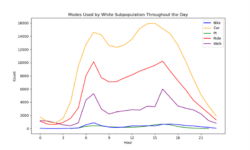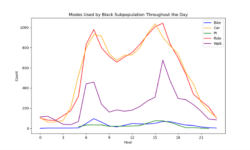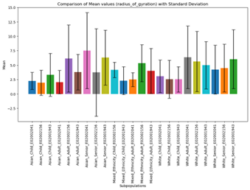Exploring inequalities in mobility behaviour with synthetic data

By Abigail Brake
This project proposes a novel approach to analysing synthetic mobility data generated from an agent-based model.
Project overview
Part of our ongoing research into mobility involves the production of large-scale agent-based models that allow us to predict and understand individuals’ mobility through the transport infrastructure. This phase focuses on the latter. It makes use of Scikit-mobility, an as yet underutilised tool for analysing synthetic mobility data.
Data and methods
The project uses MATSim output data produced from a synthetic population of 10% sample of the population of the West Midlands for a duration of one day. This is then run through Elara (a plan and event handling tool from partners Arup) and analysed using Scikit-mobility. Supplementary data is added from the ONS’ Rural Urban Classification, as well as demographic characteristics for the synthetic population. Together, this is used to create pipeline for mobility analysis of a variety of demographics against individual measures of entropy, distance travelled and locations visited. It also explores patterns of transportation mode choice throughout the day for each demographic.
Key findings
Initial findings revealed some unsurprising trends, in that long-term sick and unemployed subpopulations tended to visit the same few locations closer to home more frequently, which could be hypothesised as being due to health and financial reasons; and that subpopulations in rural areas had less public transport use and travelled the highest distance from home while those in urban areas had a low radius of gyration, likely because urban subpopulations don’t have to travel as far for amenities.
Other findings were less obvious: an interesting discrepancy was noted between the mode preference of white vs other ethnicities, whereby all other ethnicities were almost as likely to drive as be a passenger, while the white subpopulation showed a clear preference for driving.


This trend indicates a greater propensity for some groups to ride share. Given these findings ethnicity was chosen to study further, looking at intersections with other characteristics such as sex, age group, and home MSOA which might highlight more specific inequalities in transport access. Preliminary explorations do indeed highlight differences across the network both spatially and in terms of demographics.

Value of the research
Now that a pipeline for analysis is in place, considerable further research can be conducted on future iterations of the agent-based model. It could be used to provide indications on the potential impact of different interventions on local communities, such as how access might be improved or hindered by new public transport routes or pedestrianisation.
Insights
- Value can be gained through applying traditional mobility analysis tools to novel synthetic data.
- In this case, it highlighted surprising discrepancies between the travel patterns of different ethnic groups.
- This pipeline can be used to explore the impact of hypothetical changes to the transport infrastructure prior to implementation.
Research theme
Societies
Programme theme (select all that apply)
- Statistical Data Science
- Visualisation Extended Reality
- Mathematical and Computational Foundations
- Data Science Infrastructures
People
Abigail Brake, Data Scientist, University of Leeds
Ed Manley, Professor of Urban Analytics, University of Leeds
Dustin Foley, Research Software Engineer, University of Leeds
Manon Predhumeau, Research Fellow, University of Leeds
Funders
Funded by Consumer Data Research Centre
